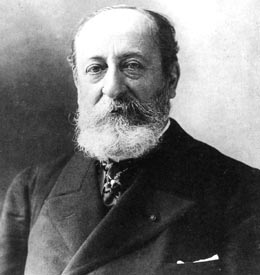
This is just awesome. I can't believe how awesome this is. It's so... awesome.
Structurally the piece is pretty straightforward... three main sections, with an initial theme in the first section, a development into a totally different middle section, and then a return to the theme and then a coda. I love the strong triplet motif, it makes the piece have a really compelling sense of forward motion.
There's an interesting passage right before the coda in which Saint-Saens shows us his more dissonant sensibilities... it's a series of very heavy, very strange chords that sound... demented, to say the least. It was pretty shocking to me when I first heard it, considering how normal the rest of the piece is tonally. After listening to it a few times though, I've concluded that it's actually really ingenious -- it sets up the coda perfectly, because they contrast in so many ways -- rhythmically, tempo-wise, tonally, texturally, etc. so the effect of the coda is more exaggerated. This brings me to another point -- the coda is one of the coolest things ever. It's very light, very quick, and extremely compelling. I think some composers and musicians underestimate the power of scherzando codas to really move the audience and create a dramatic effect. One example is in Rachmaninov's concerto no. 3 in D minor, where he wrote two cadenzas, one which was very heavy and chordal, and one that was very light and quick. Some pianists prefer the chordal one because it's so intense, but I find the other one more powerful actually, and I think a lot of it has to do with the ability to build in intensity.
The recording I've provided is the best I can find on youtube, the only one with a decent tempo and technical proficiency, however I own one of Rubinstein playing that I think is the best I've heard so far.
The rest of the concerto is good too, I recommend listening to the entire thing -- the second movement sorta breaks form from most concerti, which is interesting, and it is also somewhat quick and light and character.
SPECIAL THANKS TO PATRICK KIM for discussing these topics with me at length and letting me have a copy of his recording of the piece.
No comments:
Post a Comment